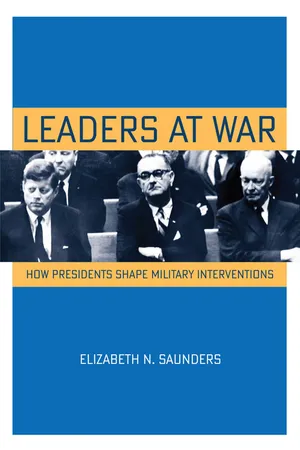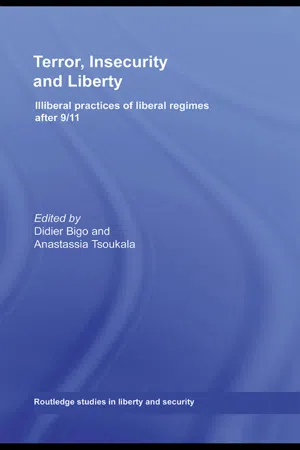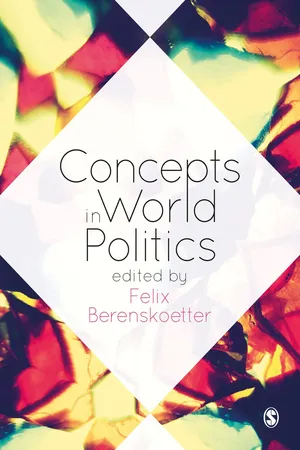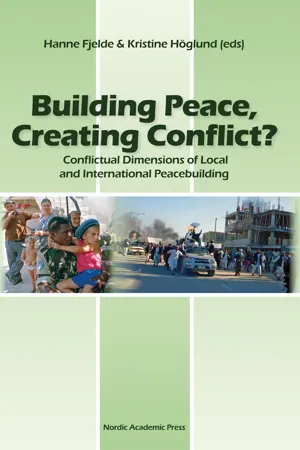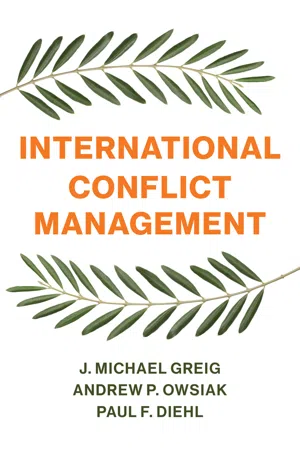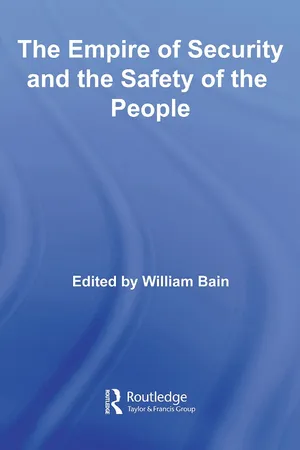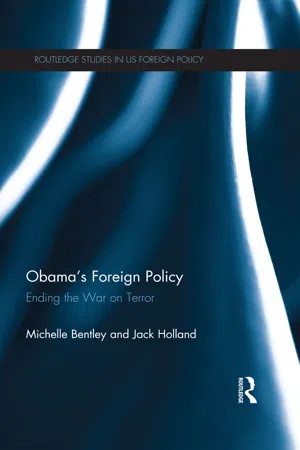Politics & International Relations
US Intervention
US intervention refers to the involvement of the United States in the affairs of other countries, often through military, economic, or diplomatic means. This can include actions such as military interventions, peacekeeping operations, or providing aid and support to foreign governments. US intervention has been a significant aspect of global politics and has sparked debate and controversy both domestically and internationally.
Written by Perlego with AI-assistance
Related key terms
Related key terms
1 of 4
Related key terms
1 of 3
9 Key excerpts on "US Intervention"
- eBook - ePub
Cornell Studies in Security Affairs
How Presidents Shape Military Interventions
- Elizabeth N. Saunders(Author)
- 2011(Publication Date)
- Cornell University Press(Publisher)
3 Furthermore, such a definition obscures variation in the depth of internal interference. Many interventions that technically involve some interference in the domestic affairs of the target state do not attempt to change the target state’s institutions directly, even if the intervention itself has long-term internal consequences. The 1958 U.S. intervention in Lebanon, for example, ostensibly shored up Lebanon’s domestic order but stopped short of direct interference in Lebanese domestic institutions. The intervention was largely a demonstration of the credibility of U.S. security guarantees in the wider context of the Cold War in the Middle East. Additionally, many scholars analyze the problem in terms of specific types of intervention, such as interventions in civil wars, humanitarian crises, alliance defense, or democratization, resulting in largely separate literatures. There remains little general theorizing about when states undertake certain types of intervention or choose among different options for intervention in a single crisis.Rather than define intervention too narrowly, I follow Finnemore in treating variation in the purpose and nature of intervention as part of the phenomenon to be explained, and I argue for a definition that allows the depth of domestic interference to vary. I therefore define military intervention as an overt, short-term deployment of at least one thousand combat-ready ground troops across international boundaries to influence an outcome in another state or an interstate dispute; it may or may not interfere in another state’s domestic institutions.The components of this definition help bound the universe of cases. For example, “short-term” may encompass a wide range of time frames but is intended to capture the idea that intervention is not aimed at conquest or colonialism. The universe of potential interventions encompasses both interstate and intrastate crises, including state failure and humanitarian crises. Both interstate and intrastate crises have attracted intervention, and both can be undertaken with varying degrees of internal interference. Depending on the leader’s threat perception, there may also be a subjective element in what “counts” as a potential intervention. An internally focused leader, for example, may see domestic changes in other states as grounds for intervention, increasing the number of potential interventions for that leader. Furthermore, the same crisis may attract the attention of potential interveners for different reasons because many crises contain both international aspects and dimensions associated with the domestic politics of the potential target state. In other crises, the nature of the conflict may be ambiguous. In defining the universe of potential interventions, I exclude cases in which leaders were restrained by a clear risk of nuclear escalation, as in the Berlin crisis of 1961 and other cases in which the United States might have intervened in Eastern Europe. - eBook - ePub
Terror, Insecurity and Liberty
Illiberal Practices of Liberal Regimes after 9/11
- Didier Bigo, Anastassia Tsoukala, Didier Bigo, Anastassia Tsoukala(Authors)
- 2008(Publication Date)
- Routledge(Publisher)
6 Military interventions and the concept of the politicalBringing the political back into the interactions between external forces and local societies
Christian Olsson
The ‘global war against terrorism’ is the overarching rationale, if not the main motivation, of two major, international, but US-led, military interventions in Afghanistan since 2001, and in Iraq since 2003. These anti-terrorist interventions, although they both have been justified discursively or legally by ‘exceptional circumstances’, have in many ways challenged and changed our common understanding of the place of interventionist behaviour in international politics. But what is less frequently underscored, is that these interventions have seen major developments in military practices on the ground. The shift from ‘wars between states’ to ‘wars within states’ has highlighted the importance of the relation between intervening forces and local populations: the relational dimension of the political seems to prevail over the purely strategic relation of interstate war. One could have asked whether we are talking about wars at all (in the historical sense of the term), if it were not for the justification of these interventions by a ‘global war’, the long-term implications of which are still difficult to assess. Therefore any political analysis of these interventions would have to start with the concept of war. There are two ways of grasping the relation between the political and war.The first consists of analysing the political through the specific field of practices called politics.1 In this case, the central problem is to identify which one of the two fields of practices, politics or war, can be inferred from the other. Several classical insights can be mentioned here. In the Clausewitzian perspective, war as a practical reality – as opposed to war as a theoretical category – ought to be considered as ‘the continuation of politics by other means’. According to this insight, the political dimension of war is to be found in the political ends of which war is a means. In other words, the political refers to the ends, other than the military ends themselves of course that are pursued by war.2 Hence, in interstate wars, which are the ones that interest Clausewitz, the political refers to the state, or rather to the will and the practices of the professionals of politics, who speak and act in the name of the state. Michel Foucault has formulated a more provocative perspective in his analyses of the political theory of Hobbes. He simply reverses the first adage.3 - eBook - ePub
- Felix Berenskoetter, Felix Berenskoetter(Authors)
- 2016(Publication Date)
- SAGE Publications Ltd(Publisher)
16 InterventionDavid ChandlerThis chapter seeks to analyse fundamental shifts in the concept of intervention since the end of the Cold War by tracing the political and ideational context through which the normative perception, function and performance of intervention has been transformed. It does this with the view, highlighted in the introductory chapter to this volume, that concept analysis is not so much concerned with changes in formal definitions as with the semantic fields within which a concept operates. Indeed, concepts can maintain their broad definitional “meaning” while being understood very differently in different socio-historical contexts. Complementing broader historical overviews, such as that by Reus-Smit (2013), this chapter shines light on shifts in Western understandings of the concept of intervention since the end of the Cold War in relation to both traditional disciplinary understandings of sovereignty in IR and to Western, liberal or modernist forms of knowledge. It thus adopts elements from both the historical and the political (critical) approach, highlighting changes in meaning over time and how these changes are embedded in Western foreign policies seeking to order the world, including understandings of conflict and effective forms of governance.In international law, intervention is a legal term for the use of force by one country in the internal or external affairs of another. In most cases, intervention is considered to be an unlawful act but some interventions may be considered lawful, as acts of self-defence or when supported by the UN Security Council to uphold international security. This chapter is not concerned with the legal debates surrounding this issue, not least because it holds that the traditional focus on military intervention must be complemented by an understanding of intervention through practices falling under the broad label of development. At a deeper level, this chapter shows how debates over international intervention have seen a shift from political concerns of sovereign rights under international law to concerns of knowledge claims of cause and effect highlighted through the problematisation of interventions’ unintended consequences. This can be illustrated by contrasting the difference between the confidence – today, critics would say “hubris” (Mayall and Soares de Oliviera, 2011) – of 1990s’ understandings of the transformative nature of external intervention and current, much more pessimistic, approaches. - eBook - ePub
The World Turned Upside Down?
Socialist Register 2019
- Greg Albo, Leo Panitch(Authors)
- 2018(Publication Date)
- Monthly Review Press(Publisher)
intervention, whose supporters press to reconfigure the post-1945 international order with a view to juridifying ever more ambitious forms of interference. The struggle between those who seek to preserve and those who seek to upend those elements of the post-1945 settlement that relate to the use of force is a struggle over both the form and content of contemporary international law, one with wide-ranging politico-economic implications. Contemporary humanitarian intervention is not simply an outgrowth of a particular mode of great-power politics reflective of post-Cold War dynamics. It is also a juridical complement to the transformation of territories and populations that were formerly suspicious of unfettered privatization. This has proven to be the case from Kosovo to Iraq, where state building following military intervention has proceeded alongside the institution of new social property regimes and the introduction of new trade and investment policies. 47 There is little reason to think that it will not continue to prove the case in the future. When all is said and done, the modes of humanitarian intervention with which we are currently confronted are remarkably similar, both formally and substantively, to earlier incarnations. Even when government officials do not explicitly offer a particular legal rationale, as with Trump’s 2017 Shayrat strike, much of the political, diplomatic, and journalistic work that is done to arm the operation with ideological authority trades upon the essential logic of such intervention. In this respect, the interventions of the past few years, though responsive to shifts in the international balance of forces, have not deviated significantly from the path staked out by those who resuscitated ‘just war’ claims of various kinds after the Cold War. For obvious reasons, humanitarian interventions have traditionally been undertaken by advanced capitalist countries against weaker states, near and far - eBook - ePub
Building Peace, Creating Conflict?
Conflictual Dimensions of Local and International Peacebuilding
- Hanne Fjelde, Kristine Höglund(Authors)
- 2012(Publication Date)
- Nordic Academic Press(Publisher)
Such a world-view tends to assume that power operates through intentional domination, or more insidiously through persuasion, and hence that the intervener can affect the political authority in the target state in a top-down, zero-sum, and instrumental way. However, many would agree that interventional power actually functions in a two-way, messy, asymmetrical way. Perhaps in recognition of this, many post-Cold War interventions actively seek the cooperation and consent of host agents, especially, but not exclusively, host governments. 2 Lastly, we view external intervention as analytically distinct from other kinds of outsider–insider interface. An intervention is a special kind of response to the diagnosis of an ‘extraordinary’ and assumedly time-limited set of circumstances (conflict, underdevelopment, lack of governance, and so on) in which action is considered necessary for a delimited period of time. The action is not intended to be permanent, although there are cases where this is not straightforward. Intervention differs from governance, government, or policy, which constitute more ‘normal’, long-term actions. However, the dividing line is not crystal clear since interventions are not necessarily short-term and instead can be protracted, as would appear to be happening with the current military intervention by the US in Iraq. This example also illustrates the way in which governance and intervention may overlap; governance takes on the guise of intervention, or interventions become governance. Drawbacks of a top-down perspective The political world order in the twentieth century was dominated by the idea of the Westphalian nation-state, predicated in turn on national sovereignty, non-recognition of supranational authority, demarcated borders and non-interference in the internal affairs of individual states. The twenty-first century, however, has already seen a burgeoning of different forms of outside interference and intervention by non-state actors - eBook - ePub
International Intervention, Identity and Conflict Transformation
Bridges and Walls Between Groups
- Timea Spitka(Author)
- 2015(Publication Date)
- Routledge(Publisher)
The type of external intervention process has an impact on conflicting parties and their identities. Regardless of intention, this impact can be positive or negative, moving the parties towards or away from resolution. The main question addressed is the conditions under which external processes include elements that contribute towards building bridges between conflicting groups and the conditions under which the international intervention process contributes towards hardening group identities. I contend that reaching a consensus among principal mediators on either a united–neutral or a united–partisan intervention process in a conflict is a key to a successful intervention. However, this has not been possible in many conflicts. Divided intervention has not only hindered resolution, it has heightened divisions between groups. This section will outline the key types of international intervention processes – neutral, partisan, united and divided – and discuss some of the causes behind the type of intervention and the impact on groups in conflict.External intervention is a broad term encompassing diplomacy, humanitarian assistance, international mediation, arbitration, economic pressure or incentives, covert and overt military action as well as the threat of sanctions or the promise of rewards. The focus of this study is on diplomatic or international mediation efforts to end a violent conflict. However, when international diplomatic and mediation efforts are accompanied by military or other measures, these will also be addressed. Recent international mediation attempts have commonly been supplemented with economic, military, legal or other measures. In complex international interventions such as in Bosnia and Herzegovina (BiH), the international community used multi-faceted intervention that included diplomatic, humanitarian, economic and military measures, all with varying degrees of success and failure. Presuming the official intention of the external intervener is altruistic – to facilitate a resolution – the emphasis is on mediation, as military and economic interventions can be assessed in either contributing to or hindering diplomatic efforts to end a conflict.Although in decline since the 1990s, violent conflicts continue to break out within states, providing external actors with opportunities and obligations for intervention (Kriesberg 2009). According the Uppsala Conflict Data Base (UCDP), since World War II there have been 228 armed conflicts throughout the world, the highest number (51 conflicts) occurring in 1991 and 1992 (Harbom and Wallensteen 2005). The overwhelming majority of them have been internal and took place in developing countries, particularly in Africa and Asia. Wallensteen and Sollenberg noted that, of the 108 conflicts that took place between 1989 and 1998, 92 were intrastate (Wallensteen and Sollenberg 2000). Although categorized as internal, external interveners frequently play a role whether in mediation, supplying weapons, providing financial assistance or sanctions. Since the end of the Cold War, external actors provided some type of military or economic support in 80 out of 111 conflicts (Harbom and Wallensteen 2005). In 2013, UCDP recorded 33 armed conflicts and six signed peace agreements (Themner and Wallensteen 2014). As noted by Lotta Themner and Peter Wallensteen, external mediators played an important role in all of the signed peace agreements. - eBook - ePub
- J. Michael Greig, Andrew P. Owsiak, Paul F. Diehl(Authors)
- 2019(Publication Date)
- Polity(Publisher)
3InterventionWhen Iraq invaded Kuwait in August 1990, it violated numerous international norms, including those against violating national sovereignty and the use of military force. In earlier centuries, such an act, along with the seizure of territory that accompanied it, might have been tolerated and even legitimated by other states in the international system. But in this instance, a coalition of military forces from multiple states (primarily from the United States, Saudi Arabia, the United Kingdom, and Egypt) intervened to drive Iraqi forces out of Kuwait and restore the Kuwaiti government to power.It achieved this in little over a month, thereby ending the initial violence through military victory. The continuing security guarantees and placement of US and UK troops, as well as the establishment of no-fly zones, then provided the mechanisms to manage the conflict further, albeit without resolving the underlying sources of dispute.Although common usage applies the term “intervention” to any third-party involvement in an ongoing conflict (that is, any conflict management approach covered in this book), we employ a narrower conception of the term. Intervention occurs when a third party introduces military forces into an existing war or a conflict with high levels of violence. Thus, verbal support or financial aid in support of a combatant does not constitute intervention, unless done in conjunction with military forces. Examples of intervention under this definition include Saudi Arabia’s air cover and actions in the Yemeni civil war, the establishment of no-fly zones (e.g., over Kosovo), the delivery and protection of humanitarian aid in Somalia, and the North Atlantic Treaty Organization’s (NATO) behavior in support of rebels in Libya.It might seem paradoxical to begin the substantive review of conflict management approaches by focusing on intervention. If conflict management primarily seeks to reduce violence and save lives, how does the introduction of greater military force into a situation achieve that? In short, intervention promotes the values of conflict management. Two broad prototypes of intervention exist: traditional military and humanitarian. Each has its own form and logic, but both work toward conflict management, even if they increase violence in the short run or third parties have self-interested motivations for intervening. The goals involve limiting violence, alleviating human suffering, and incentivizing a permanent resolution to the issues under dispute. - William Bain, William Bain(Authors)
- 2006(Publication Date)
- Routledge(Publisher)
Although there has been some increase, the interventionism seen since 1990 is not wholly new in either form or justification. Many recent acts of intervention have been defended rhetorically in terms similar to those used in past eras; and if the UN framework for some of today’s interventionism is new, it has no shortage of precursors in the use made of regional organizations and, in the nineteenth century, the Concert of Europe. Moreover, the suspicion endures that, even when interventions are justified in terms of high international principle, they reflect the interests of particular states. The US-led intervention in Iraq since March 2003 has been widely denounced in such terms.Nor is modern interventionism new in the reactions that it evokes. Even in a case in which an intervention has explicit authorization from international bodies, and impeccable humanitarian objectives, it is likely to arouse resistance both in the country concerned and internationally. Somalia in 1992–94 and Iraq since 2003 are the clearest examples of interveners facing, and even provoking, violent opposition within the territory concerned. Such opposition is not surprising. A foreign military presence always involves the wielding of power by outsiders with a limited understanding of a society, and it is naturally perceived as a threat not only by indigenous would-be wielders of power, but also by the population more generally.The reasons for the growth of interventionism in the past sixty years, and especially since the end of the Cold War, are extraordinarily diverse, relating as they do to the interests of particular states in particular crises, to the principles and treaties that states have adopted, and to the structure of the international system. Four are singled out here: (1) the growth of global media has made it more difficult than before for governments to ignore distant crises; (2) international terrorism – often emanating from weak or failed states, but also from some dictatorial ones – has contributed to a number of decisions to intervene; (3) in many cases since about 1970, one fundamental reason has been the concern of virtually all states to tackle the causes of massive refugee flows at source; and (4) the development of an international legal order in the UN era – governing such matters as arms control, democratic governance, self-determination, human rights, and humanitarian conduct in war – raises the question of how states are supposed to act when this body of international norms is persistently violated in a state.- eBook - ePub
- Michelle Bentley, Jack Holland(Authors)
- 2013(Publication Date)
- Routledge(Publisher)
7 Interventionism in US foreign policy from Bush to Obama Mike Aaronson DOI: 10.4324/9781315888545-8Introduction
This chapter considers the evolution of US policy and practice towards foreign military intervention under Presidents George W. Bush and Barack Obama, and in terms of strategic intent finds no evidence of substantive change. Although the language of the ‘Global War on Terror’ has been replaced by one of a ‘transnational global conflict’ the underlying policy drivers remain the same: America’s security and related interests continue to shape its foreign policy and provide the justification for an exceptionalist interpretation of international law, to the disappointment of those who hoped Obama’s election would usher in a new era of strengthened global norms. However, a change in US official thinking is evident in a greater appreciation of the limitations of certain forms of intervention, and in the emergence of alternative policy instruments to deliver US strategic objectives.Background
9/11 obliged the US to rethink its approach to homeland security. For the first time since Pearl Harbor, America was attacked on its own territory and this time not by a hostile state power deploying conventional military means, but by a non-state actor using violence to achieve political objectives. Initially supported by the vast majority of states at the UN and elsewhere, the Bush Administration passed up the opportunity to treat its attackers as international criminals to be pursued by judicial means and instead launched the ‘Global War on Terror’. This included large-scale expeditionary warfare in the Middle East and West Asia, harnessing the full might of US military and technological power. Following early success in Afghanistan, which had given shelter to the al-Qaeda organisation that had claimed responsibility for 9/11, Bush allowed himself to be distracted by Iraq. The resulting quagmire in Iraq, the gradual descent – largely through neglect – of Afghanistan into an equally intractable mess, plus the emergence of new threats in Pakistan, Yemen, Somalia and elsewhere, provided a difficult inheritance for Barack Obama when he took over as President in January 2009.
Index pages curate the most relevant extracts from our library of academic textbooks. They’ve been created using an in-house natural language model (NLM), each adding context and meaning to key research topics.
Explore more topic indexes
Explore more topic indexes
1 of 6
Explore more topic indexes
1 of 4
